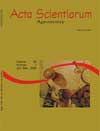Survey of diseases in soyabean, <em>Glycine max</em> (L.) Merrill, in the municipalities of western Paraná
Abstract
A survey was carried out in the western region of Parana, Brazil, to assess the occurrence and to identify diseases afflicting soybean, Glycine max (Leguminosae-Faboideae), particularly those of economic importance. Plant samples were collected from 126 commercial soybean crops growing in nine administrative areas: Marechal Cândido Rondon, Quatro Pontes, Toledo, Pato Bragado, Santa Helena, Nova Santa Rosa, Mercedes, Palotina and Terra Roxa. Samples were taken from plants showing symptoms of diseases proper to the crop. Disease symptomatology was recorded, and standard laboratory procedures, including preparation of permanent microscope slides with fungi, nematodes and fungus culture, on media culture PDA, were done to determine the causal agent of the diseases recorded. Perinneal pattern and analysis of esterase phenotype were compared for the identification of Meloidogyne spp. nematodes recovered during the survey. Twenty-one causal agents of diseases in soybean were identified during this survey. They consisted of fifteen fungi, one bacterium, one virus and four nematode species. The most widespread were Downy Mildew, Powdery Mildew, Bacterial Blight and the root-knot nematodes M. javanica and M. incognita nematosis. In a complementary study samples were collected from commercial seed lots of 16 soybean cultivars. Some lots were found to be contaminated by Fusarium sp., Colletotrichum dematium var. truncate and Phomopsis spDownloads
Download data is not yet available.
Published
2008-05-09
How to Cite
Roese, A. D., Romani, R. D., Furlanetto, C., Tangarlin, J. R., & Portz, R. L. (2008). Survey of diseases in soyabean, <em>Glycine max</em> (L.) Merrill, in the municipalities of western Paraná. Acta Scientiarum. Agronomy, 23, 1293-1297. https://doi.org/10.4025/actasciagron.v23i0.2599
Issue
Section
Agronomy
DECLARATION OF ORIGINALITY AND COPYRIGHTS
I Declare that current article is original and has not been submitted for publication, in part or in whole, to any other national or international journal.
The copyrights belong exclusively to the authors. Published content is licensed under Creative Commons Attribution 4.0 (CC BY 4.0) guidelines, which allows sharing (copy and distribution of the material in any medium or format) and adaptation (remix, transform, and build upon the material) for any purpose, even commercially, under the terms of attribution.
2.0
2019CiteScore
60th percentile
Powered by 

2.0
2019CiteScore
60th percentile
Powered by 



















































